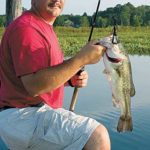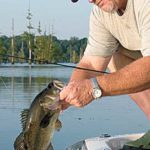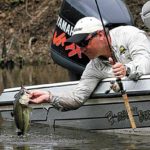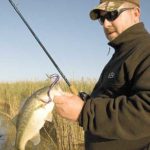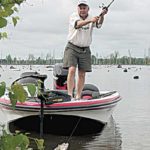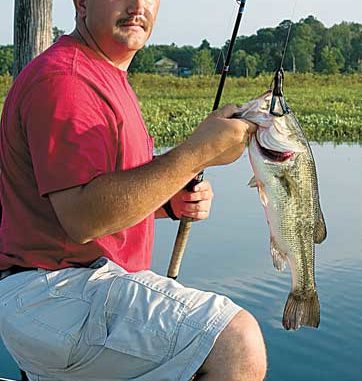
Follow these tips to put big bass in your boat on three of Louisiana’s major river systems.
During the early 1990s, it didn’t take much effort to stroke my ego by pitching a black/blue ringer worm to the many laydowns in the Ouachita River. Bass after bass with an occasional big fish or two thrown in put me very close to river-rat status.
The signs were pretty innocuous at first — a skipped chemistry class, calling in sick to work, pulling out of the dorm parking lot early in the morning with my Bass Tracker Tournament TX 17 in tow while cars full of drunk partiers were pulling in.
Although I was starting to fancy myself a river rat, it only took one bass tournament on the Ouachita River to make me realize that I was more river runt than rat. The real river rats were obvious because their weigh-in sacks were bulging from the weight of bass rather than water like mine.
Years passed without my graduating to river-rat status, and I am sad to say that, even today, I still look up in awe at those anglers who are known for catching the biggest bass Louisiana’s rivers have to offer. Apparently, they fish by an entirely different set of rules than most of us.
These are the rivers. These are the rats. These are their rules.
River: Ouachita
Rat: Dale Taylor
Rule 1: Fish at 24 Feet and Falling
North Louisiana Media Bass tournament director Dale Taylor pointed out that all the good oxbow lakes to the north and south of Monroe would be accessible with the river level at 24 feet. Catching the river while it’s falling from that level is important for catching big fish because it pulls them out of flooded cover where they are protected and piles them up in open water.
Rule 2: Look for Spawning Shad
Taylor caught the largest bass he’s ever caught by fishing spawning shad up D’Arbonne Bayou, a major tributary of the Ouachita River just north of Monroe on the west side of the river. The 10.2-pounder had trapped a ball of shad against a bluff bank. Taylor easily pinpointed the activity because the shad were doing what he called “climbing the banks” because they were trying to get away from nearby predator fish.
Taylor’s advice if you see spawning shad?
“Stop and fish because the big bass are there,” he said.
Rule 3: Fish a Spinnerbait
Although spinnerbaits catch big bass, there are probably better choices to specifically target big fish. However, Taylor believes the strong shad population on the Ouachita River makes it tailor-made for throwing a shad-imitating lure like a spinnerbait.
He pointed out one of the most popular spinnerbaits for this river is a double willow War Eagle with a blue herring skirt.
“Anything with a little blue in it is great on the river,” he said. “Although I’ve caught some really good bass on the red perch skirt that Stanley has on some their spinnerbaits.”
Rule 4: Kill your Spinnerbait by the Trees
With May ushering in lots of spawning shad, Taylor says they can frequently be found around the bases of cypress trees. Knowing that big bass often run up to slash the bait then eat the crippled ones that fall to the bottom, he likes to cast his spinnerbait past a cypress tree and burn it up to the tree. Then he kills his retrieve so his spinnerbait can fall straight down beside the trunk to the big bass waiting below.
Rule 5: Fish the Cypress Trees in Boggy Bayou
While Taylor’s spinnerbait-killing technique works well around cypress trees all up and down the river, the cypress trees in Boggy, an expansive cypress flat up D’Arbonne Bayou, are too good to try only that.
Taylor reads the trees based on their position. Lines of trees signal a creek channel, and clusters of trees point out humps or sloughs. The best trees are those near these kinds of depth changes.
Flipping jigs and Texas-rigged creature baits is very productive, as is crashing crankbaits into the tree trunks and fishing Devil’s Horse or Bang-O-Lure propeller baits slowly right next to the bases of the trees.
River: Mississippi
Rat: Cade Thomas
Rule 1: Fish Interior Ponds with Good Grass
Bass at Venice will begin to get into their early summer patterns during May, and that means they’re going to move back into interior ponds that are full of lush, green grass.
Capt. Cade Thomas, who is known for whacking a few bass between saltwater guiding trips, looks for ponds that have hydrilla or coontail. Finding grassy ponds is even more important now that Hurricane Katrina destroyed so much bass habitat that was closer to the Gulf of Mexico. The ponds around Delta Duck and The Wagon Wheel would be good choices.
Rule 2: Fish the Voids in the Grass
Many of the best ponds with good grass will also have voids, or empty spaces, within the grass beds. Thomas says these voids are there because of subtle changes in the bottom that cause the grass to stop growing.
A big void may be 10 feet in diameter, and the depth under the grass may be 2 to 3 feet. However, there is a slight drop where the grass stops growing. Thomas says it may be as slight as a half-foot drop.
“Three feet down to 3 1/2 feet would be significant around Venice,” he said. “It sounds simple, but bass will either be under the mat, at the edge or in the void.”
Rule 3: Tie on Weedless Lures
Being that he’s going to be fishing thick grass from May throughout the rest of the summer, Thomas fishes lures he knows will come through the grass easily and without fouling.
His favorites for fishing the grass mats are topwater frogs like the Stanley Ribbit or Zoom Horny Toad. These lures are hot for summer fishing because they will catch fish that explode through the mat and those that follow to the edge.
For fishing the voids, Thomas relies on Texas-rigged plastic worms, although he’ll sometimes fish them just like the frogs.
“Anything you can work over the grass and let flutter down at the edge will work,” he said.
Rule 4: Fish a Falling Tide
Bass are like redfish in that they will move up with rising water. That means they often push so far back into the canes that anglers can’t reach them. However, when the tide starts falling, bass are forced back into the ponds where they will stack up at little drains and cuts that flow into the pond to eat the bait being washed out.
Rule 5: Fish the Rocks if the Water is Clean
Although the ponds hold the best bass fishing during May, Thomas says the rock levees across from The Jump and down Grand Pass will offer good bass fishing if the river is low and clean. The rocks down Grand Pass have some drains and canals that come out into Grand Pass itself, and banging a deep-diving crankbait, something that goes about 10 or 12 feet deep, will provide a lot of action.
“You can also try a Rat-L-Trap,” Thomas added. “It will work better if the fish are higher in the water.”
River: Red
Rat: Russ McVey
Rule 1: Fish Topwaters First
May is a great topwater month on the Red River, according to guide Russ McVey, who holds the record for the largest bass, a 13.63-pound giant, caught from the Red.
With so much grass between the main river and the oxbows, McVey begins every morning throwing buzz baits or topwater frogs over the mats and around the edges. Before they retreat into the grass as the sun gets high, bass will go on a feeding binge for about an hour after daybreak.
Rule 2: Look for Hyacinths Near Deep Water
McVey noted that big bass would only spend a small portion of their day in shallow water. That’s why he looks for water hyacinths that are very close to deep water. These floating mats of cover provide big bass a great place to move up out of deep water to eat while offering quick retreats back to the security of the deep water from which they came.
Rule 3: Go Big or Go Home
When fishing the thick mats of water hyacinths, McVey routinely rigs up with 3/4- to 1 1/4-ounce Tru-Tungsten weights rigged in front of soft-plastic creature baits or craws like the NetBait Paca Craw. The heavy weight is necessary to penetrate the thick cover of hyacinths that offer very little wiggle room for baits to go through.
McVey also spools up with a minimum of 50-pound-test braided line. Going heavy allows him to get to the fish and get them out.
“Make sure to peg your sinker because you don’t your weight and bait sliding apart,” he said.
Rule 4: Bedding Bream Point Out Bass
By May, McVey fully expects bream to be bedding in shallow water in many of the oxbow lakes off the Red River. Since lots of these beds will be in shallow water with deep water nearby, it offers McVey the best of both worlds — a place to fish topwaters early and a place to back off and fish deep later in the day.
“When the topwater bite dies, you can fish jigs and Texas rigs in the deeper wood and grass later in the day,” McVey said.
Rule 5: Fish the Community Holes
According to McVey, there aren’t any secrets left in pools 4 and 5 of the Red River. All the best spots are well known because they have been prominently featured on fishing shows for the last few years. Also, spectator anglers often follow their favorite tournament anglers to their fishing spots, so they can go back and fish them later.
McVey pointed out Caspiana, the Bobo Hole and White House in Pool 5, and he mentioned Sullivan’s and the Jungle in Pool 4.
“Those places are community holes for a reason; they hold big fish,” McVey said. “The great thing about them is they have that shallow and deep water combination that is so important for catching big fish on the Red River.”
One thing you can say about river rats is they know exactly what to do to catch bass on Louisiana’s three major river systems. Follow their rules and catch fish. Before too long, anybody who knows you and is looking for you should know exactly where to find you.
